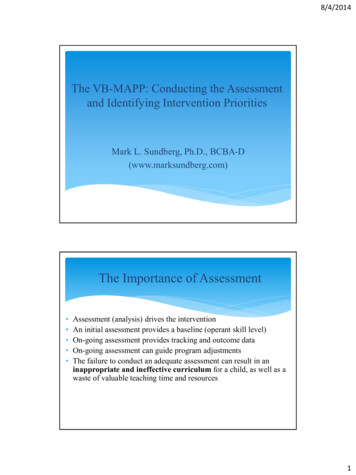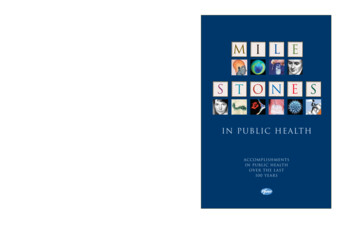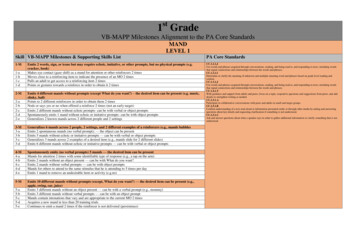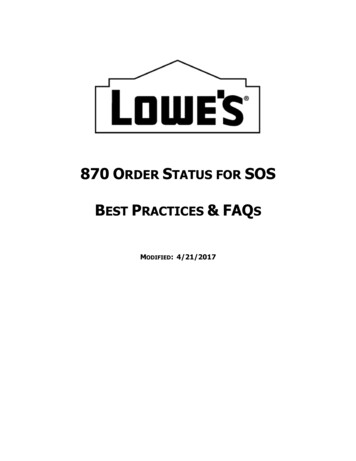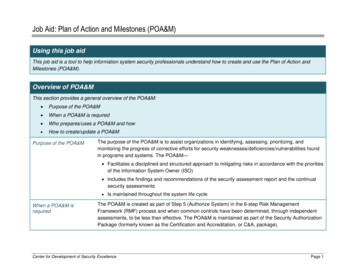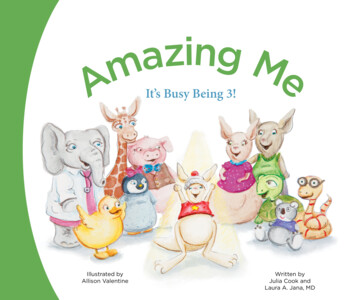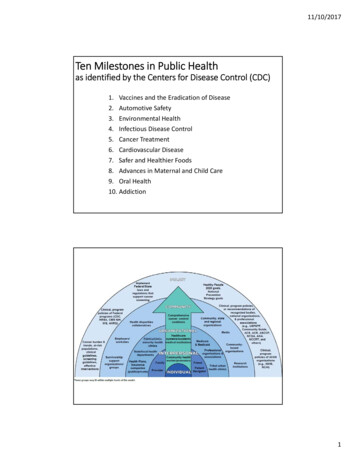
Transcription
11/10/2017Ten Milestones in Public Healthas identified by the Centers for Disease Control (CDC)1. Vaccines and the Eradication of Disease2. Automotive Safety3. Environmental Health4. Infectious Disease Control5. Cancer Treatment6. Cardiovascular Disease7. Safer and Healthier Foods8. Advances in Maternal and Child Care9. Oral Health10. Addiction1
11/10/2017The Social‐Ecological d from: Dahlberg LL, Krug EG. Violence-a global public health problem.In: Krug E, Dahlberg LL, Mercy JA, Zwi AB, Lozano R, eds. World Report on Violence and Health.Geneva, Switzerland: World Health Organization; 2002:1-56Retrieved from: el DVP.htm3Individual Factors: The first level identifies biological and personalhistory factors that increase the likelihood of a publichealth issue Some of these factors are age, education, income,substance use, or history Prevention strategies at this level are often designedto promote attitudes, beliefs, and behaviors thatultimately prevent violence. Specific approaches mayinclude education and life skills training.2
11/10/2017Vaccines andDiseasePreventionModuleImpact of VaccinesLearning Objectives1. Explain the impact of vaccines and vaccine‐preventable diseases2. Describe the history of vaccine development and its impact onpopulation health3. Explain the key scientific basis for the success of vaccines63
11/10/2017Impact of Vaccines in the 20th C.Atkinson, W., Wolfe, S., Hamborsky, J., & McIntyre, L. (Eds.). (2009). Impact of vaccines in the20th & 21st Centuries. In Centers for disease control and prevention: Epidemiology and prevention of vaccinepreventable diseases (Appendix G: Data and statistics), (11th ed.). Washington, D.C.: Public Health Foundation.Retrieved from s/appendices/G/impact-of-vaccines.pdf7Germ Theory of Disease Germ theory of disease states that many diseases are causedby microorganism The reproduction and growth of these germs within the hostcause the disease “Germ” can refer to any microorganism in this sense; not onlybacterium This idea goes back to antiquity in several cultures Antonie Van Leeuwenhoek (1632 – 1723) invented themicroscope, and the theory was confirmed by scientists thereafter Bacteriology begins following these advances in scientific know‐how84
11/10/2017Pasteur, Spontaneous Generation, and Biogenesis Louis Pasteur (1822 – 1895) French microbiologist and chemist Known for his advancement and contributions to: Vaccination Microbial fermentation Pasteurization His medical discoveries provided direct support for the germtheory of disease and its application in clinical medicine Best known to the general public for his invention of thetechnique of treating milk and wine to stop bacterialcontamination a process now called pasteurizationHe is regarded as one of the three main founders of bacteriology, with:Ferdinand Cohn, andRobert Koch Pasteur is popularly known as the "father of microbiology"9Pasteur, Spontaneous Generation, and Biogenesis Spontaneous generation was a theory that described howliving organisms could arise from inanimate things Like maggots would arise from dead flesh (without eggs) First formalized by Aristotle Pasteur foiled this theory by conducting an experiment in 1859 He boiled meat broth in a specially designed flask that allowedair to flow while separating particles from the broth This lead to the theory of biogenesis the belief that complex living things come only from other living things,by means of reproduction – i.e., life does not spontaneously arise fromnon‐living material and later to the process of pasteurization a process that kills microbes (mainly bacteria) in food and drink105
11/10/2017What is a ‘Vaccine’? A vaccine is formally defined as:“a preparation of killed, weakened, or fully infectious microbes that is given toproduce or increase immunity to a particular disease” The Dictionary of Public Health defines vaccine as:“The biologically active antigen, usually in liquid solution or colloid suspensionthat is injected or taken orally to immunize (vaccinate) individuals againstcommunicable diseases. It may be prepared from a culture of live attenuatedor killed organisms or from organisms with antigenic properties closely similarto those of the pathogen from which the vaccine is intended to provideprotection”11What is a ‘Vaccine’? Vaccines can be administered as: An injection,Swallowed orally,Nasal sprayAnd other newer, innovated ways Vaccines fall into three broad categories:1.Live (attenuated) Vaccine Uses live, weakened version of the virus itself Usually provides lifelong immunity Examples: measles, mumps, and rubella (MMR)2. Killed (inactivated) Vaccine Uses a pathogen exposed to Formalin – a chemical that kills its genetic material Requires several injections over time Examples: typhoid and Hib (a bacterial illness that can lead to a brain infection in children)3. Toxiod Vaccine:1.2.3.Uses protein toxins that have been secreted by pathogenic bacteria, but are inactiveRequires several injections over timeExamples: Diphtheria and tetanus126
11/10/2017What is a ‘Pathogen’? A bacterium, virus, or other microorganism that cancause disease (biology) There are several substrates including pathways wherethe pathogens can invade a host The principal pathways have different episodic timeframes However, soil contamination has the longest or most persistentpotential for harboring a pathogen Diseases caused by organisms in humans are known aspathogenic diseases13Types of Pathogens Bacterial – (most pathogens are of bacteria) Viral Fungal Prionic –(protein material that do not contain nucleic acids) Parasites (other) Algal147
11/10/2017Vaccine‐Preventable Diseases Anthrax Cervical Cancer Diphtheria Hepatitis A Hepatitis B Haemophilus influenzae type b (Hib) Human Papillomavirus (HPV) Influenza (Flu) Japanese Encephalitis (JE) Lyme Disease Measles Meningococcal Monkeypox Mumps Pertussis (Whooping Cough) Pneumococcal Poliomyelitis (Polio) Rabies Rotavirus Rubella (German Measles) Shingles (Herpes Zoster) Smallpox Tetanus (Lockjaw) Tuberculosis Typhoid Fever Varicella (Chickenpox) Yellow Fever15History of Vaccines: New Vaccines 1798 ‐ Smallpox 1885 ‐ Rabies 1897 ‐ Plague 1917‐ Cholera 1917 ‐ Typhoid vaccine (parenteral) 1923 ‐ Diphtheria 1926 – Pertussis (whooping cough) 1927 ‐ Tuberculosis (BCG) 1927 ‐ Tetanus168
11/10/2017History of Vaccines: New Vaccines (Cont.) 1935 ‐ Yellow Fever 1940s – DTP (Diphtheria, Tetanus, and Pertussis) 1945 ‐ Influenza 1963 ‐ The first measles vaccine licensed 1967 ‐ Mumps vaccine licensed 1969 ‐ Rubella vaccine licensed 1970 ‐ Anthrax vaccine manufactured by the Michigan Departmentof Public Health 1971 ‐ Measles, Mumps, Rubella vaccine licensed (MMR) 1981 ‐ Meningococcal polysaccharide vaccine, groups A, C, Y,W135 combined (Menomune)17History of Vaccines: New Vaccines (Cont.) 1982 ‐ Hepatitis B vaccine becomes available 1983 ‐ Pneumococcal vaccine, 23 valent 1990 ‐ Haemophilus influenzae type B (Hib) polysaccharideconjugate vaccine licensed for infants 1990 ‐Typhoid vaccine (oral) 1995 ‐ Hepatitis A vaccine licensed 1998 ‐ First rotavirus vaccine licensed 2004 ‐ Pediarix, a vaccine that combines the DTaP, IPV, and Hep B 2006 ‐ RotaTeq is a new rotavirus vaccine from Merck 2006 ‐ Gardasil, the first HPV vaccine is approved189
11/10/2017History of Vaccines: Health Outcomes Milestones 1977 ‐ Last indigenous case of smallpox (Somalia) 1979 ‐ Last case of polio, caused by wild virus, acquired in the United States 1980 ‐ Smallpox declared eradicated from the world 1999 ‐ Rotavirus vaccine withdrawn from the market due to adverse events 2003 ‐ Measles declared no longer endemic in the Americas 2005 ‐ Rubella declared no longer endemic in the United StatesAtkinson, W., Wolfe, S., Hamborsky, J., & McIntyre, L. (Eds.). (2009). Impact of vaccines in the20th & 21st Centuries. In Centers for disease control and prevention: Epidemiology and prevention of vaccinepreventable diseases (Appendix G: Data and statistics) (11th ed.). Washington, D.C.: Public Health Foundation.Retrieved from s/appendices/G/impact-of-vaccines.pdfHistory of Vaccines: Challenges and Set‐backs 1964 – 1965 ‐ 20,000 cases of Congenital Rubella Syndromeoccurred during the largest rubella epidemic in the U.S. 1976 ‐ Swine Flu: largest public vaccination program in the U.S. todate halted by association with Guillain‐Barré syndrome 1989‐1991 ‐ Major U.S. resurgence of measles 55K cases compared with low of 1,497 cases in 1983 Two‐dose measles vaccine (MMR) recommended2010
11/10/2017History of Vaccines: Challenges and Set‐backs (Cont) 1999 ‐ Rotavirus vaccine withdrawn from the market as a resultof adverse events 2001 ‐ September 11 results in increased concern of bioterrorism The U.S. establishes a plan to re‐introduce smallpox vaccine if necessary, avaccine thought never to be needed again 2007 ‐ HIV vaccine trial failsAtkinson, W., Wolfe, S., Hamborsky, J., & McIntyre, L. (Eds.). (2009). Impact of vaccines in the20th & 21st Centuries. In Centers for disease control and prevention: Epidemiology and prevention of vaccinepreventable diseases (Appendix G: Data and statistics) (11th ed.). Washington, D.C.: Public Health Foundation.Retrieved from s/appendices/G/impact-of-vaccines.pdf21Efforts toEradicateSmallpoxHistory of Vaccines: The Model ofSmallpox11
11/10/2017Vaccines and Disease PreventionSmallpox What is smallpox? Acute contagious disease caused by a virus Origin: 3000 years ago in Egypt or India. Virus family: Poxviridae or poxvirus. Forms:1. Variola minor (killed one in 100)2. Variola major (killed one in three) Transmission: Airborne droplet There is no cure, but vaccination can be used very effectively to prevent infectionfrom developing if given during a period of up to four days after a person has beenexposed to the virus12
11/10/2017Smallpox What is smallpox? Acute contagious disease caused by a virus Origin: 3000 years ago in Egypt or India. Virus family: Poxviridae or poxvirus. Forms:1. Variola minor (killed one in 100)2. Variola major (killed one in three) Transmission: Airborne droplet There is no cure, but vaccination can be used very effectively to prevent infectionfrom developing if given during a period of up to four days after a person has beenexposed to the virusSmallpox Smallpox is/was: The first disease for which a vaccine was created, and The first disease that was eradicated by humankind! Prior to the development of the vaccine, a technique known as variolation had been inuse for centuries Populations in China, India, Turkey and other parts of the world would introducescrapings of smallpox sores into healthy people During the late 18th century, Lady Mary Wortley Montague, the wife of a Britishambassador to China, observed this custom and discussed this practice in Europeansocial circles During the same period, a physician named Edward Jenner learned from milkmaids thatthose who were previously exposed to cowpox developed protection against smallpoxduring subsequent epidemics Most of them became immune, but between about 1% and 2% of those variolated in thisway died13
11/10/2017Edward Jenner The discovery of smallpox vaccination is generallyattributed to the English physician Edward Jenner In 1796 Jenner noticed that milkmaids never seemed to getsmallpox because they had caught what he thought was cowpox Jenner set out to prove this by scratching the arm of an eight‐year‐old boynamed James Phipps and deliberately infected him with cowpox pus takenfrom a blister on the hand of a milkmaid! Months later, he infected the boy using pus taken from a smallpox patient! The boy didn’t develop the disease! The cowpox had made him immune!Edward Jenner It was not until 1938 that another scientist,Allan Watt Downie, realized that cowpox did not make peopleimmune from smallpox but a related virus, called vaccinia virus Jenner coined the term ‘vaccination’ from the Latin word for cow, vaccus In the 1870s, Louis Pasteur developed preparations that protected peopleagainst rabies and anthrax He coined the term ‘vaccine’ for this type of preparation in honor of Jenner’saccomplishments “Vaccinia” is truly the world’s first vaccine In the USA, Dryvax became the first approved vaccinia virus vaccine in 1931 In 2003, because of the concern for biological warfare, the USA governmentrecommended that all first responders be vaccinated with the vaccinia virus14
11/10/2017SIR,‐‐ I have received a copy of the evidence at large respecting the discovery of thevaccine inoculation which you have been pleased to send me, and for which Ireturn you my thanks. Having been among the early converts, in this part of theglobe, to its efficiency, I took an early part in recommending it to mycountrymen. I avail myself of this occasion of rendering you a portion of thetribute of gratitude due to you from the whole human family. Medicine hasnever before produced any single improvement of such utility. Harvey'sdiscovery of the circulation of the blood was a beautiful addition to ourknowledge of the animal economy, but on a review of the practice of medicinebefore and since that epoch, I do not see any great amelioration which has beenderived from that discovery. You have erased from the calendar of humanafflictions one of its greatest. Yours is the comfortable reflection that mankindcan never forget that you have lived. Future nations will know by history onlythat the loathsome small‐pox has existed and by you has been extirpated.Accept my fervent wishes for your health and happiness and assurances of thegreatest respect and consideration.‐Thomas Jefferson to Edward Jenner, May 4, 2.phpGlobal Eradication of Smallpox In 1967, the World Health Organization (WHO) targeted smallpox foreradication from the planet by the end of the 20th century The WHO achieved this goal, with the last endemic case of smallpoxreported in Somalia in 1977 and eradication declared in 1980 This effort was successful for several reasons, including the lack of anynatural reservoir for variola virus and the ease of identifying infectedindividuals Who receives the credit for the eradication of smallpox? This has beensomewhat of a controversy, so we will try to sort out the details 15
11/10/2017Global Eradication of Smallpox Governments of Developed Countries around the world first seriouslydiscussed the possibility of eradication in 1953 at the annual World HealthAssembly, but there was little enthusiasm for the idea Sceptics pointed to several failed attempts to eradicate other diseases: hookworm at the turn of the 20th century while efforts to stamp out yellow fever had been called of in 1932 World Health Organization’s own campaign to eradicate malaria was justgetting under way in the 1950s – a massive undertaking that succeeded insome countries of the Americas, Asia and Europe, but failed in Africa Given widespread doubt in the 1950s that any disease could be eradicated, itrequired someone with more than just technical knowledge of smallpoxcontrol to give WHO’s program its first real impetus Who is credited with succeeding in this WHO effort to rid the world ofsmallpox?Viktor Zhdanov (1914 – 1987) According to the WHO, it was Soviet scientist, Viktor Zhdanov! Speaking at the World Health Assembly in 1958, Zhdanov, anepidemiologist by training and deputy health minister of thewhat was the U.S.S.R., called for the total eradication of the smallpox virus Born in the Ukraine, Zhdanov was a Soviet virologist (who may have alsoworked in the USSR’s biological weapons program) He had assisted in containing smallpox USSR in the 1930s Zhdanov believed the Soviet success could be repeated elsewhere He proposed a four‐year global vaccination campaign starting in 195916
11/10/2017Viktor Zhdanov (1914 – 1987) Zhdanov also brought his belief in a technique knownas lyophilization, or freeze‐drying, which had been developedduring World War II for dried blood plasma Soviet research in the 1950s had shown that several pharmaceuticalproducts could be preserved in this way, including the smallpox vaccine Freeze‐dried vaccine can be transported and reconstituted when needed This was unlike other vaccines, like polio, which has to be refrigerated,greatly complicating the task of getting it into the field Zhdanov believed that freeze‐dried vaccine would be an essential tool inWHO’s smallpox eradication program, and said the Soviet government wouldfurnish WHO with suppliesThe World Rally’s to Eradicate Smallpox By the end of 1966, smallpox was still circulating in 31 countries andterritories In 1965, President Lyndon B. Johnson announced that the USA wouldfully support a program to eradicate smallpox in 20 countries of westand central Africa and backed the idea of global smallpox eradication Only 2.4 million USD were pledged (about 19m USD in today’s value) President Johnson said: "as long as smallpox exists anywhere in the world, no country is safe from it.This dread disease spreads so rapidly, that even a single case creates the threatofepidemic. It is clear that every nation of the world, whether or not it hasexperiencedsmallpox in recent years, has a major stake in a worldwide eradication program."17
11/10/2017Donald Henderson (1928 ‐ 2016) Born in Ohio, Henderson was a medical physician andepidemiologist Henderson served as Chief of the CDC virus disease surveillance programsfrom 1960 to 1965 He and his unit developed a proposal for a United States Agency forInternational Development (USAID) program to eliminate smallpox andcontrol measles during a 5‐year period in 18 contiguous countries in westernand central Africa In 1966, Henderson was sent to Geneva to head WHO’s Smallpox Eradicationunit From 1967 to 1977, Henderson led an international effort of the WHOto eradicate smallpox from the world This project was funded by USAID, with field operations beginning in 1967,but was also the jumpstarter for the WHO’s program to eradicate smallpoxthroughout the world in 10 yearsSmallpox Eradication Today: Smallpox eradication timeline: North America ‐ 1952Europe ‐ 1953South America – 1971Asia ‐ 1975Africa – 1977smallpox was never widespread in Australia In 1975, a three‐year‐old girl from Bangladesh, was the lastperson in the world to have naturally acquired variola major andthe last person in Asia to have active smallpox She was isolated at home with house guards posted 24 hours aday until she was no longer infectious A house‐to‐house vaccination campaign within a 1.5 mile radiusof her home began immediately, and every house, publicmeeting area, school, and healer within 5 miles was visited by amember of the Smallpox Eradication Program team to ensurethe illness did not spread A reward was also offered to anyone for reporting a smallpoxcase18
11/10/2017AutomotiveSafetyModuleContext: The Milestone andits Impact on Public HealthNHTSA 2020 Report3819
11/10/2017Timeline20th Century Motorization of America1896First recorded fatality occurred inLondon in an onlooker during ademonstration driveSeptember First U.S. fatality occurred in NYC1899Mid‐1960s Modern injury science emerged as adistinct field1985Shift of focus: Accident prevention toinjury prevention39CDC (2006)4020
11/10/2017CDC (2006)41The ProblemMotor vehicle injuries occur at all stages of life and includesthe following issues:1. Alcohol‐related motor vehicle injuries2. Child passenger safety3. Older adult drivers4. Road traffic safety5. Teens behind the wheelCDC (2006)21
11/10/2017Alcohol‐Related Crashes An alcohol‐related motor vehicle crash kills someone every 31minutes and injures someone non‐fatally every 2 minutes More than 1.4 million drivers were arrested for driving under theinfluence of alcohol or narcotics About 3 in 10 Americans are involved in an alcohol‐related crashin their lifetimes The number of alcohol‐related fatal crashes is growing Costs Americans approximately 51B annuallyCDC (2006); Quinlan et al. (2005), Dept. of Justice (2005)Child Passenger Safety Motor vehicle injuries are among the greatest publichealth problem facing U.S. children today During 2003, a total of 1,591 children aged 14 yearsand younger died as occupants in motor vehiclecrashes, and approximately 220,000 were injured Most of these children were riding unrestrained, thusmany of these injuries could have been prevented Drinking and driving are injury and fatality risk factorsfor childrenCDC (2006)22
11/10/2017Older Adult Drivers In 2002, a total of 7,688 people ages 65 and older diedin motor vehicle crashes in the U.S. Drivers ages 65 and older have higher crash deathrates per mile driven than all but teen drivers Rates for motor vehicle‐related deaths and injury aretwice as high for older men as for older women Motor vehicle‐related deaths and injuries among olderadults are risingCDC (2006)Teens Behind the Wheel Motor vehicle‐related injuries are the biggest healththreat to teens in U.S. Account for 2/5 of deaths overall In 2002, 5,000 teens, ages 16‐19 died of injuries causedby motor vehicle crashes Risk highest among 16‐19 year‐olds Cost (fatal and non‐fatal) involving drivers 15‐20 yearswas 40.8 billion in 2002CDC (2006)23
11/10/2017Road Traffic Safety Road traffic crashes kill 1.2 million/year worldwide Road traffic crashes injure or disable 20 million to 50million each year Ranks as 11th cause of death and account for 2% of alldeaths globally By 2020, road traffic injuries predicted to become 3rdlargest contributor to global burden of disease Economic cost of road traffic injuries is an estimated 518billionCDC (2006)Public Health and the motorization of America Six times as many people drive today as in 1925 the number of motor vehicles in the country has increased 11‐fold since then to approximately 215 million The number of miles traveled in motor vehicles is 10 timeshigher than in the mid‐1920s More than 79,500 adults ages 20 to 49 died from injuries in 2002 Motor vehicle crashes were the leading cause of those deathsCDC (2006)24
11/10/2017Public Health and the motorization of America Systematic motor‐vehicle safety efforts began during the 1960s In 1960, unintentional injuries caused 93,803 deaths 41% were associated with motor‐vehicle crashes In 1966, after 5 years of continuously increasing motor‐vehicle‐related fatality rates,the Highway Safety Act created the National Highway Safety Bureau (NHSB), whichlater became the National Highway Traffic Safety Administration (NHTSA) The systematic approach to motor‐vehicle‐related injury prevention began with NHSB'sfirst director, Dr. William Haddon Haddon, a public health physician, recognized that standard public health methods andepidemiology could be applied to preventing motor‐vehicle‐related and other injuries He defined interactions between host (human), agent (motor vehicle), andenvironmental (highway) factors before, during, and after crashes resulting in injuriesFour Types of Energy (Cont.) Kinetic: falls, motor vehicle crashes Electrical: lightning strikes, downed wires Chemical: poisonings Thermal/Radiant Energy: steam or flame burns Two types involved in motor vehicle crashes Kinetic Thermal25
11/10/2017Energy the Main Cause of Injury The Body’s Response to Injury Each body tissue has a unique ability to absorb and dissipateenergy without injury until a critical threshold is reached Tissue Fragility and Injury Threshold comorbid factors; age as a factor Tissue Healing Injury Mechanics Kinetic energy causes the majority of injuriesHaddon Matrix (1973) Haddon described basic strategies that prevent energy from reachingpeople at rates or in amounts that are harmful These strategies can be summarized as:1. not producing energy or potential sources of energy, or reducingthe amount of energy e.g., not making gunpowder) reducing the speed capabilities of cars2. preventing or modifying the release or transfer of energy (e.g., having safety catches on guns) slowing the burning rate of cloth padding automobile dashboards3. separating people from potentially injurious sources of energy using barriers phasing traffic putting electric lines out of reach26
11/10/2017Haddon Matrix ventPost‐event53Haddon Matrix ‐ Factors The matrix of four columns and three rows combines public health concepts of host‐agent‐environment as targets of change with the concepts of primary, secondary, andtertiary prevention More specifically, the factors defined by the columns in the matrix refer to theinteracting factors that contribute to the injury process The host column refers to the person at risk of injury The agent of injury is energy (for example mechanical, thermal, electrical) that istransmitted to the host through a vehicle (inanimate object) or vector (person or otheranimal) Physical environments include all the characteristics of the setting in which the injuryevent takes place (for example a roadway, building, playground, or sports arena) Social and legal norms and practices in the culture are referred to as the socialenvironmentRunyan, 198827
11/10/2017Haddon Matrix ‐ Phases The phases in Haddon's initial configuration referred to rows in thematrix These are the phases at which change would have its effect pre‐crash crash, or post‐crash These have been broadened beyond the motor vehicle arena toencompass other injury problems by using the terms “pre‐event,”“event” and “post‐event” By identifying interventions that fit within each cell of the matrix onecan generate a list of strategies for addressing a variety of injury orother public health problemsRunyan, 1988Runyan, et. al.’s 3rd Dimension to HaddonThe third dimension of thematrix incorporates the useof value criteria in thedecision making processEach needs to be carefullythought through in thecontext of the injurycountermeasure beingconsidered, whether: a policyi.e., drinking age laws a programi.e., training of bartenders not toserve underage or inebriatedcustomers or a technologicalinterventioni.e., an ignition interlock device28
11/10/2017Haddon Matrix ‐ Use First is planning whether using the matrix or any other technique Clearly identify clearly the problem to be addressed using appropriatedata from the community to assess need Before using the matrix to derive potential interventions, it isnecessary to identify the injury issue to be addressed; i.e., falls from playground equipment, bicycle crashes, bathtub drownings, childphysical abuse, or residential fires Second, one needs to define each row and column of the matrix The host is the person in the car The vectors in this example are the vehicles safety features The social environment refers to the social norms, policies, and procedures that governsuch practicesRunyan, 1988Applying Haddon Matrix to Motor Vehicle Crashes(McKay 2008)Host / Human Pre‐Event IntoxicationSafety Belt le Tire PressureBrake FunctioningI BeamsCrumple ZonesPhysical/SocialEnvironment Speed Cameras Weather Social Culture Willingness to allowothers to drive drunkEvent Frailty Age Size Post‐Event Body Mass Index Age Co‐morbid Degree of crush EMS response Fuel System integrity Trauma Center availability Rehab ProgramsSpeed of ImpactAir BagsSizeStiffness of SurfacesStability Control FlammabilityGuard railsStiffness of fixed objectsBarriersEmbankmentsconditions29
11/10/2017Motor vehicle deaths are recorded two ways:The Auto Safety industry uses the‘per vehicle miles traveled (VMT) unitThe Public Health discipline uses the‘per 100,000 people’ unit30
11/10/2017The U.S. Department of Transportation’sNational Highway Traffic SafetyAdministrations (NHTSA) maintainsstatistics on traffic fatalities andmonitors trends in highway safety.The mission of the NHTSA is to:Save lives, prevent injuries, andreduce economic costs due to roadtraffic crashes through education,research, safety standards, andenforcement activity31
11/10/2017US DOT National Health Traffic Safety Administration –Latest Stats: The 2016 national data shows that: Distraction‐related deaths (3,450 fatalities) decreased by 2.2 percent; Drowsy‐driving deaths (803 fatalities) decreased by 3.5 percent; Drunk‐driving deaths (10,497 fatalities) increased by 1.7 percent; Speeding‐related deaths (10,111 fatalities) increased by 4.0 percent; Unbelted deaths (10,428 fatalities) increased by 4.6 percent; Motorcyclist deaths (5,286 fatalities) increased by 5.1 percent; the largest number of motorcyclist fatalities since 2008 Pedestrian deaths (5,987 fatalities) increased by 9.0 percent; the highest number since 1990 Bicyclist deaths (840 fatalities) increased by 1.3 percent – the highest number since 1991Using colored lanes todifferentiate various lanes forvarious modes of transportHere, green indicates a bike landand the red curb is indicatespedestrians32
11/10/201733
11/10/2017Smart Street Design – Lane widthsLane widths should beconsidered within theassemblage of a givenstreet delineating spaceto serve all needs,including travel lanes,safety islands, bikelanes, and sidewalks.Smart Street Design – SidewalksAs public spaces, sidewalks serve as the front steps to the city, activating streets socially and economically.Safe, accessible, and well‐maintained sidewalks are
Ten Milestones in Public Health as identified by the Centers for Disease Control (CDC) 1. Vaccines and the Eradication of Disease 2. Automotive Safety 3. Environmental Health 4. Infectious Disease Control 5. Cancer Treatment 6. Cardiovascular Disease 7. Safer and Healthier Foods 8. Advances in Ma


